Comptroller Kevin Lembo Archive > News
COMPTROLLER LEMBO PROJECTS $56.2-MILLION DEFICIT FOR FISCAL YEAR 2017Comptroller Kevin Lembo today announced that the state is on track to end the current fiscal year with a $56.2-million deficit.
Lembo said that his deficit projection remains slightly higher than the Office of Policy and Management’s (OPM) due to a variance in estimated claims expenditures in the adjudicated claims account related to settlement payments in the SEBAC vs. Rowland case. While OPM projected claims expenditures to be $9 million, Lembo said there is a chance that it could reach $23.6 million if settlement payments are not delayed.
In a letter to Gov. Dannel P. Malloy, Lembo said that continued active budget management could ultimately eliminate the deficit, and that this month will be particularly important because the estimated payment component of the income tax typically realizes its largest collections during December and early January.
A new consensus revenue forecast by OPM and the legislature’s nonpartisan Office of Fiscal Analysis is scheduled for Jan. 15.
“The January consensus estimates will incorporate significant new collection data,” Lembo said. “It’s also important to note that there are several positive economic indicators that could be promising if sustained - though it’s too soon to be anything other than cautiously optimistic.”
Overall General Fund revenue is currently expected to fall $45.9 million short of the initial budget target with shortfalls in the income tax, sales tax and federal receipts partially offset by an $80-million legal settlement awarded to the state and an $18.1 million gain in estimated provider tax payments.
Lembo estimates that state spending will exceed the budget by a net $33 million and he noted that OPM’s budget estimates rely on significant savings targets that, while not historically high, could be difficult following successive fiscal years of significant cost cutting.
“Connecticut’s budget performance is dependent upon the performance of the national and state economies,” Lembo said. Lembo pointed to some of the latest economic indicators from federal and state Departments of Labor and other sources that show:

• In Fiscal Year 2016 the withholding portion of the income tax increased 3.4 percent from the prior fiscal year. Through November of Fiscal Year 2017, these receipts are up 4.9 percent from last year. To date withholding collections have been running ahead of last fiscal year throughout the first five months of Fiscal Year 2017 after adjusting for major deposit days within the month.
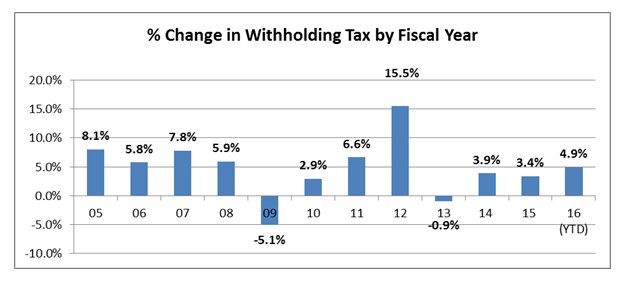
• Preliminary Connecticut nonfarm job estimates from the business
establishment survey administered by the U.S. Bureau of Labor Statistics (BLS)
show the state gained 2,100 payroll jobs in November 2016 to a level of
1,679,900, seasonally adjusted. October’s initial job loss figure of 7,200 jobs
was adjusted to a loss to 5,800 positions.
• The establishment survey indicates that the state has added an anemic 1,400
payroll positions over the past 12-month period ending in November. It should be
noted that this survey has been subject to some major revisions in past years
when it is benchmarked for the full calendar year. Other data, including
withholding receipts and the household census survey, indicate Connecticut’s job
performance has been better than the establishment survey has indicated.
• Based on the establishment survey, Connecticut has now recovered 72 percent or
85,700 of the 119,100 jobs lost to the Great Recession.
• As the state’s employment recovery has progressed, an increasing number of job
sectors have posted employment gains.
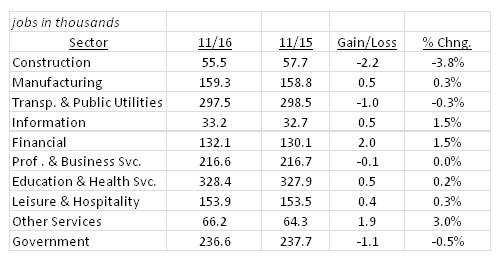
• U.S. employment has been advancing at a rate of 1.6 percent over the
12-month period ending in November; Connecticut’s employment growth pending
final benchmark adjustment was 0.1 percent during that period.
• Connecticut’s unemployment rate was 4.7 percent in November; the national
unemployment rate was 4.6 percent. Connecticut’s unemployment rate has continued
to decline from a high of 9.5 percent in October 2010.
• There were 88,300 unemployed job seekers in Connecticut in November. A low of
36,500 unemployed workers was recorded in October of 2000. The number of
unemployed workers hit a recessionary high of 177,200 in December of 2010.
![]()
• Average hourly earnings at $30.56, not seasonally adjusted, were up $0.67, or
2.2 percent, from the November 2015 hourly earnings estimate. The resultant
average private-sector weekly pay amounted to $1,029.87, up $19.59, or 1.9
percent higher than a year ago.
• Connecticut ranked 11th nationally in income growth for the 3rd quarter of
2016 based on personal income statistics released by the Bureau of Economic
Analysis on Dec. 20. Among the New England states, only Massachusetts and New
Hampshire outpaced Connecticut’s growth. Connecticut’s annualized personal
income growth based on 3rd quarter results was 4.9 percent. While this is still
off the pace of the last recovery period, it continues a recent pattern of
quarterly improvement.
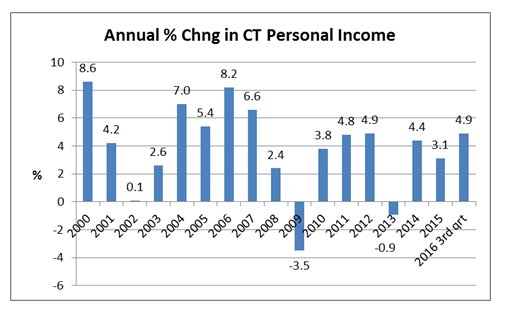
• Personal income statistics for 4th quarter personal income growth will be released on March 28.

• According to a Dec. 21 release from CT Realtors, Connecticut single-family
residential home sales increased 15.9 percent in November 2016 from the same
month a year earlier. The median sale price also posted an increase of 6.0
percent to $249,000. This marks the third consecutive month of price increases,
and it reverses a persistent trend of monthly declines in home prices. Townhouse
and condominium sales increased 12.6 percent in November and prices increased
4.1 percent to $154,000.
• The National Association of Realtors (NAR) reported that U.S. sales of
existing homes including condominiums rose 15.4 percent in November from one
year ago to a seasonally adjusted annual rate of 5.61 million. Sales through
November were at strongest pace since February 2007.
• The average number of days that a house remained on the market nationally was
43 in November compared to over 70 days in Connecticut.
• Nationally, home prices have been rising far faster than wage gains. The
median price of an existing home sold in November was $234,900, up 6.8 percent
on the year. This was the 57th consecutive month of price increase in the U.S.
housing market. U.S. house prices are back over pre-crash level and continue to
accelerate.
• First-time home buyers accounted for 32 percent of November sales, according
to NAR, down from 33 percent in October, but up from 30 percent in November of
2015. Conventional fixed-rate mortgages jumped from 3.47 percent in October to
3.77 percent.
Consumers
• Retail spending growth pulled back in November rising 0.1 percent from
October and 3.8 percent from 12 months ago. Economists had expected a November
monthly increase in the 0.3 percent range. Motor vehicle and parts dealers
declined 0.5 percent on the month, but were still up 3.3 percent from last
November. The decline suggests the U.S. automobile market, which had a
record-setting year in 2015, is beginning to cool.
• November department store sales slipped 6.4 percent from the same time last
year. Sales at electronics and appliance stores fell 3.8 percent from a year
earlier, and general merchandise purchases fell 1.3 percent. Sales at non-store
retailers, a category that includes internet merchants, were up 11.9 percent
compared with a year earlier. That suggests online sellers are receiving a
growing share of holiday sales.
• The chart below shows the last three months of retail sales activity, with a
focus on sales, excluding and including automobiles.
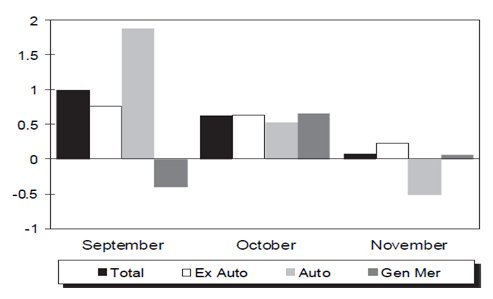
• According to the Conference Board’s December survey, U.S. consumer
confidence is at its highest level in more than 15 years (since August 2001) as
Americans saw more strength ahead in business conditions, stock prices and the
job market. A separate confidence measure, released by the University of
Michigan in December, found that Americans are more confident in the economy
than at any point in nearly 13 years.
• The Federal Reserve Bank reported on Dec. 7 that overall consumer credit
advanced at an annual rate of 5.2 percent in October. Revolving credit rose at
an annual rate of 3 percent, while non-revolving credit rose at an annual rate
of 6 percent. In raw dollar terms this came to a net gain of $16 billion in
October.
• Revolving credit has been climbing throughout 2016. It was $974.9 billion in
August, then $979.0 billion in September, and now $981.3 billion in October.
Non-revolving credit remains the larger source of growth due to student loans
and auto loans. The non-revolving credit was $2.7146 trillion in August, and
that rose to $2.7323 trillion in September and finally to $2.746 trillion in
October. To put these numbers in perspective, the National GDP in the 3rd
quarter of 2016 was $18.7 trillion.
Business and Economic Growth
• According to the Dec. 22 third estimate from the Bureau of Economic
Analysis, GDP in the 3rd quarter of 2016 grew at a 3.5-percent annual rate. The
rate was revised up from last month’s 3.2-percent estimate, and is the strongest
quarterly pace of growth in two years.
• Consumer spending, which added 2 percentage points to GDP, rose at a 3-percent
annual rate, up from the prior estimate of 2.8 percent. Business investments
rose at a revised 1.4-percent rate, much stronger than the previous estimate of
a 0.1-percent rise. The trade sector was also a positive for growth in the 3rd
quarter. Exports rose 10 percent, helped by a temporary boom in U.S. soybean
shipments.
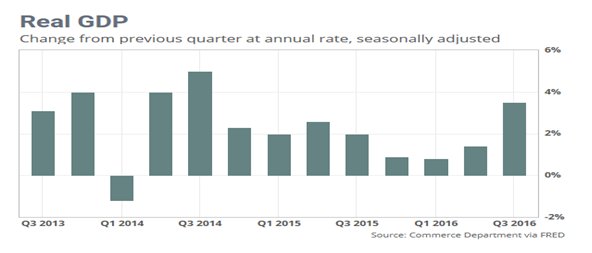
• The solid increase in GDP lowers the probability of a recession in the near
term.
• Corporate profits also continued rebounding in the 3rd quarter. Profits rose
5.8 percent on a quarterly basis and were 2.1 percent above the 3rd quarter of
last year.
• Third-quarter earnings gains were led by technology, utilities, basic
materials, financial and consumer-discretionary companies. Real estate, health
care and financials showed the most improvement in revenue.
• Corporate profits have been constrained in recent years by various forces
including weak global growth, a strong dollar, and slumping commodity prices
that contracted the energy and agriculture sectors. But business earnings have
shown signs of stabilization this year as some of those past pressures have
weakened.
• The Commerce Department reported that durable goods orders in November fell
4.6 percent, the first decline in five months. This follows an October gain in
orders of 4.8 percent. The drop in durable goods orders was largely due to a
pullback in orders for transportation equipment, which plunged by 13.2 percent
in November after a gain of 12.3 percent in October. Orders for non-defense
aircraft and parts led the transportation decline in November dropping by 73.5
percent after jumping by 94.6 percent in October.
• Excluding orders for transportation equipment, durable goods orders rose by
0.5 percent in November after climbing by 0.9 percent in October. The Commerce
Department also said orders for non-defense capital goods excluding aircraft, a
closely watched indicator of business spending, climbed by 0.9 percent in
November after edging up by 0.2 percent in October. Economists view this as a
hopeful sign of stronger business investment in 2017.
• The service-sector, which is the largest sector of the economy, continued to
growth in December, although the rate of expansion was lower than the recent
October peak due to slightly slower growth in new work orders. The Markit Flash
U.S. Services PMI Business Activity Index, adjusted for seasonal influences, was
53.4 in December compared to a 54.6 reading in November. Any reading above 50
indicates an expansion in the service sector.
• Service providers indicated an optimistic assessment of their growth outlook
for the coming 12 months. The rate of new business growth was at one of the
strongest levels seen in 2016. The rate of job creation for the service sector
was at its highest level since March.
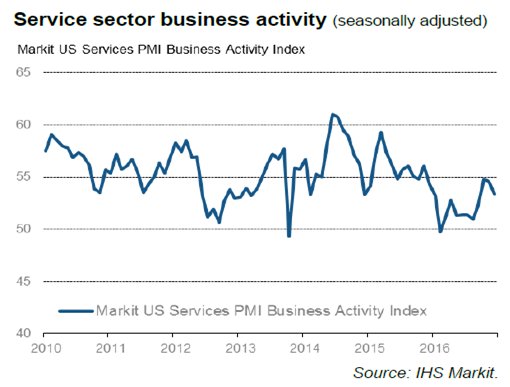
Stock Market
• Estimated and final income tax payments account for approximately 40
percent of total state income tax receipts. Both the estimated and final
payments had a negative rate of growth in Fiscal Year 2016.
• The first large estimated income tax payment for Fiscal Year 2017 was made in
September. Estimated payments, net of accrual activity, were down 11.4 percent
from last year after the September filings. It should be noted that last fiscal
year, as well as in Fiscal Year 2014, the patterns established in September were
not consistent with the trends during the remainder of the fiscal year. It is
likely that taxpayers adjusted payments in January to address their anticipated
tax liability for the prior calendar year.
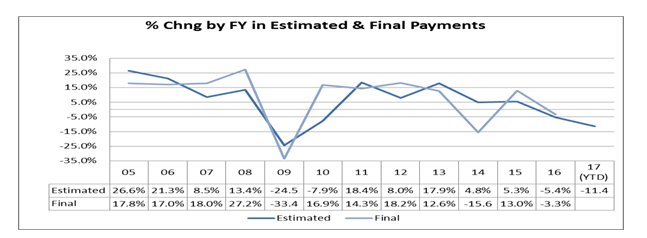
• The graphs below show the year-to-date movement in the DOW and the NASDAQ respectively at this writing.
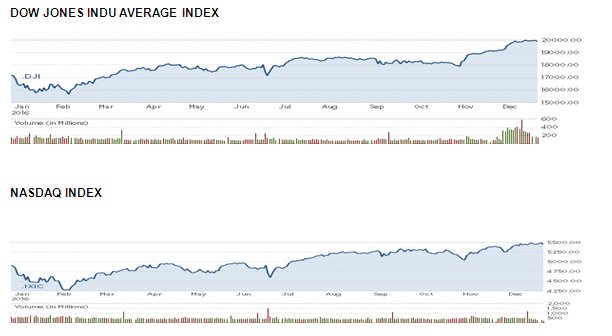
***END***
